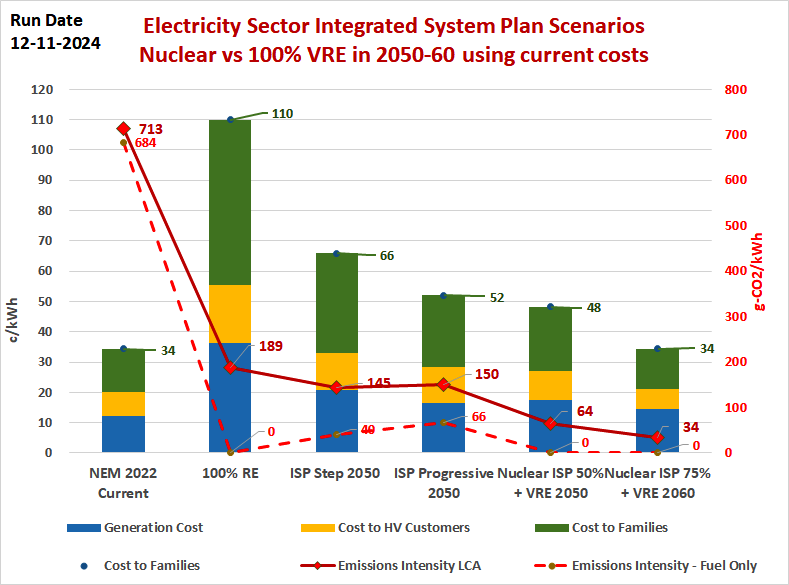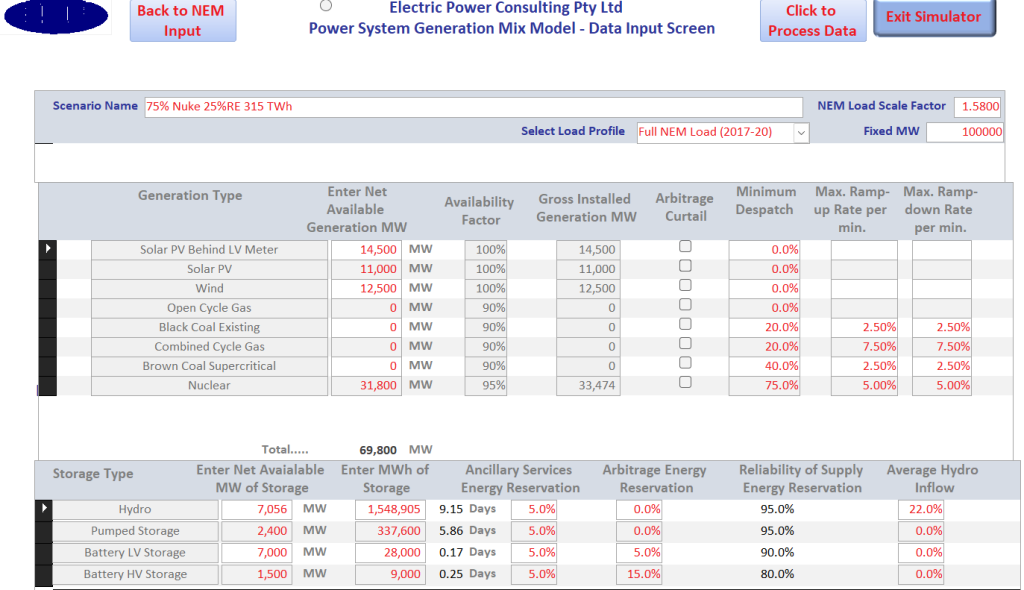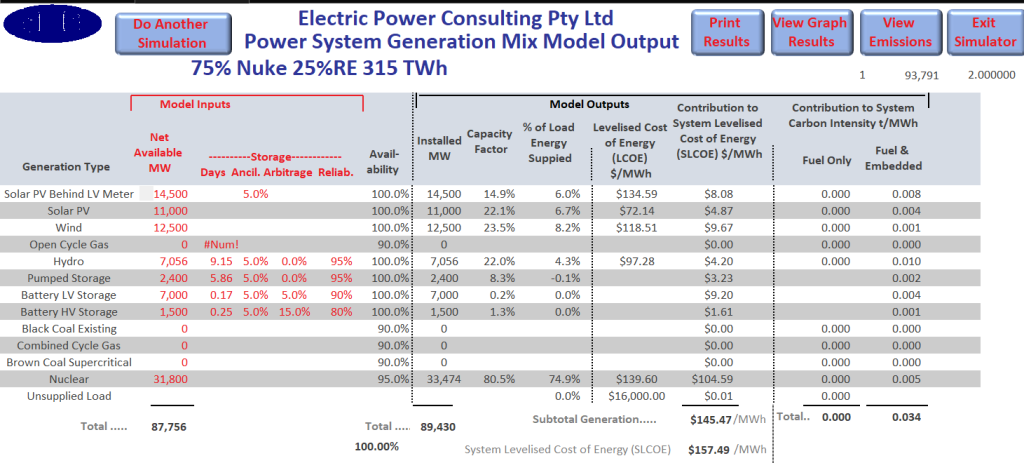
Analysing Our Electrical Energy Options
Edition 4 – 29/11/2024
Analysing our Electrical Energy Options
An energy model of the National Electricity Market (NEM) has been created by Dr Robert Barr of Electric Power Consulting
This model compares the energy outputs of any range of generating devices to meet the grid demand. The demand takes the actual profile over three years from January 2017 through to January 2020 at half hourly intervals. This typically represents an annual metered system load not including behind the meter roof top solar of about 183 Terrawatt Hours (TWh)
Wind and solar energy outputs and installed capacities over this period were obtained from the Australian Energy Market Operator. This enables a “trace” to be created that can be matched to any desired increase or decrease in wind and solar generating capacity. For example, in the three years in question the NEM had ongoing increases in wind and solar capacity which are matched to actual generation output at that time.
Using the actual renewables output “trace” means the model automatically accounts for seasonal changes in solar output and wind fluctuations over a three year period. It captures for example the June 2017 wind drought. Three years is a significant sampling period however, longer durations will result in greater fluctuations caused by even longer wind droughts, extended El Nino or La Nina events and other drivers of weather patterns.
What we analysed – Nuclear and Renewables
In each of the scenarios we report total emissions on a Life Cycle Analysis (LCA ) basis and also burned fossil fuels (BFF)
SCENARIO 1 – NEM AS AT 2022 – The first is the generation mix in 2022 which was modeled to ensure the costs used and emissions intensities would be close to the reality of both our wholesale electricity market and the resulting emissions intensity. Cost to low voltage customers is 34.5 cents/kWh and emissions intensity on LCA basis of 713 gr CO2/kWh and on a BFF basis is 708 g-CO2/kWh. Generation total is 200TWh/yr
SCENARIO 2 – 100% “RENEWABLES 315TWh– The second scheme is for a 100% “renewable” scenario and to be consistent with other scenarios the chosen NEM demand is 315TWh/yr. We modelled this scenario to provide advocates of 100% RE a measure of just how difficult and expensive such a concept is. This scenario has 374GW of generating capacity plus 821 GWh of energy storage coming from 77GW of storage capacity. It is a very costly concept caused by the massive overbuild in wind, solar and storage. This results in low-capacity factors of 10.2% for roof top solar, 2.3% for grid solar and 12.3% for wind.
This in turn causes causing 60% spilled energy and large increases in transmission and distribution. Cost to low voltage customers is 1,099 cents/kWh and emissions intensity is 189 gr CO2/kWh LCA coming from huge amounts of embodied emissions while combustion emissions (BFF) are zero.
SCENARIO 3 – ISP STEP CHANGE 2050 Next, we have AEMO’s Step Change scenario in 2050. Our analysis used AEMO’s published generating and storage capacities of 86GW Roof Top Solar, 55.5GW of Grid Solar, 61.3 GW of Wind, 15.3 GW of open cycle gas and 7GW of hydro. Storage power is 56.9GW and energy is 621 GWh. We found these resources provided 315TWh/yr and not AEMO’s stated 417TWh/yr. This discrepancy has been raised with AEMO by Dr Barr but the cause has not been resolved. It may be that AEMO assume major loads adjust to a new paradigm of demand conforming to power availability regardless of the consequential costs to industry and commerce and that no curtailment actually occurs. Cost to Low voltage customers is 66 cents/kWh and a moderate emissions intensity of 145 gr CO2/kWh Life Cycle Analysis (LCA) basis and 40 g-CO2/kWh for Burned Fossil Fuels (BFF)
SCENARIO 4 – ISP PROGRESSIVE CHANGE. The fourth scenario is the less ambitious AEMO Progressive scenario in 2050. Our analysis used AEMO’s published generating capacities of 43GW Roof Top Solar, 39GW of Grid Solar, 50GW of Wind, 14GW of open cycle gas and 7GW of hydro. Storage power is 27GW and energy is 615 GWh. We found these resources provided 255TWh/yr and not AEMO’s stated 306TWh/yr. This discrepancy has been raised with AEMO by Dr Barr but the cause has not been resolved. Cost to Low voltage customers is 52 cents/kWh and a moderate emissions intensity of 122 gr CO2/kWh Life Cycle Analysis (LCA) basis and 34 g-CO2/kWh for Burned Fossil Fuel (BFF)
SCENARIO 5 – NUCLEAR ISP 50% + RE The fifth scenario generates 50% nuclear energy. The costs of operation of the nuclear power plants increases by having to operate with solar energy and wind thereby reducing their capacity factors to 81%. This scenario has a total generating capacity of 171GW and storage power of 23.8GW with stored energy of 465GWh. Cost to low voltage customers is 48 cents/kWh. and an ultra-low emissions intensity of 64 gr CO2/kWh LCA basis and 0 g-CO2/kWh for BFF
SCENARIO 6 – NUCLEAR ISP 75%+RE Finally the best cost and emissions performance comes from the 75% nuclear energy scenario This mimics the levels of the French nuclear fleet with its proven emissions reduction. The costs of operating the nuclear power plants are still elevated by having to operate with solar energy thereby reducing their capacity factors to 81%. This scenario has a total generating capacity of only 70GW and storage power of 10.9GW with stored energy of 373GWh. Cost to low voltage customers is 34 cents/kWh. and an ultra-low emissions intensity of 34 gr CO2/kWh LCA basis and 0 g-CO2/kWh for BFF
NEM Nuclear and Renewables Scenarios for 2050

Notes on Figure
- The left-hand axis shows electricity costs in c/kWh while the right-hand axis shows system emissions intensity in g-CO2/kWh on a Life Cycle Analysis basis.
- On each column blue represents cost of system generation, yellow represents extra cost for high voltage users getting energy from high and medium voltage transmission such as large industry and urban electric train systems.
- Green represents the extra cost to distribute energy from the High Voltage transmission system through to low voltage users such as general industry, small business and residential users.
- The dashed red line and data points are the emissions intensity derived from fossil fuel burning for each scenario. Burned Fossil Fuel (BFF) analysis
- The continuous red line and data points are the total system emissions intensity using Life Cycle Analysis (LCA) for each scenario.
Of the low carbon options the two nuclear scenarios have the lowest system costs and only the 75% nuclear is ultra-low carbon. The 100% Renewable, Step Change and Progressive Change fail to achieve either low or ultra-low emissions and therefore do not provide a solution that meets the requirements of the National Electricity Law.
MODEL INPUT
For our modelling the costs of generators were obtained from the CSIRO GenCost report except for nuclear energy which used:
- A$10,000/kW overnight capital cost. Increased from GenCost value of $8,655/kW
- A$8.16/MWh fuel allowance in line with Nuclear Energy Institute values
- A$31 allowed for operations and maintenance in line with Nuclear Energy Institute values
The following image shows the model input form for Scenario 6 –NUCLEAR ISP 75%+RE


